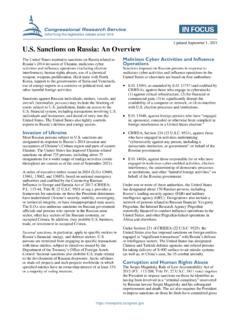Transcription of Recovery from Mental Illness: The Guiding Vision of the ...
1 William A. Anthony William A. Anthony, , is ExecutiveDirector of the Center for PsychiatricRehabilitation at Boston from Mental illness : TheGuiding Vision of the Mental HealthService System in the 1990sReprinted fromPsychosocialRehabilitation Journal,1993, 16(4), 11 implementation of deinstitutional-ization in the 1960s and 1970s, andthe increasing ascendance of the com-munity support system concept and the practice of psychiatricrehabilitation in the 1980s, have laid the foundation for anew 1990s Vision of service delivery for people who have men-tal illness . Recovery from Mental illness is the Vision that willguide the Mental health system in this decade. This articleoutlines the fundamental services and assumptions of a recov-ery-oriented Mental health system. As the Recovery conceptbecomes better understood, it could have major implicationsfor how future Mental health systems are seeds of the Recovery Vision were sown in the aftermathof the era of deinstitutionalization.
2 The failures in the imple-mentation of the policy of deinstitutionalization confronted uswith the fact that a person with severe Mental illness wantsand needs more than just symptom relief. People with severeTCHANGINGTOWARD THEFUTURE Mental illnesses may have multiple residential, vocational,educational, and social needs and wants. Deinstitutionaliza-tion radically changed how the service system attempts tomeet these wants and needs. No longer does the state hospi-tal attempt to meet these multiple wants and needs; a greatnumber of alternative community-based settings and alterna-tive inpatient settings have sprung up since deinstitutionaliza-tion. This diversity has required new conceptualizations, bothof how services for people with severe Mental illnessesshould be organized and delivered, and of the wants andneeds of people with severe Mental illness . This new way ofthinking about services and about the people served has laidthe foundation for the gradual emergence of the recoveryvision in the a prelude to a discussion of the Recovery Vision , the pre-sent paper briefly describes the community support system(CSS) concept and the basic services integral to a comprehen-sive community support system.
3 Next, the more thoroughunderstanding of the total impact of severe Mental illness , asconceptualized in the rehabilitation model, is succinctlyoverviewed. With the CSS service configuration and the reha-bilitation model providing the historical and conceptual base,the Recovery concept, as we currently understand it, is Community Support SystemIn the mid-1970s, a series of meetings at the National Instituteof Mental Health (NIMH) gave birth to the idea of a commu-nity support system (CSS), a concept of how services shouldbe provided to help persons with long-term psychiatric dis-abilities (Turner & TenHoor, 1978). Recognizing that post-deinstitutionalization services were unacceptable, the CSSdescribed the array of services that the Mental health systemneeded for persons with severe psychiatric disabilities (Stroul,1989). The CSS filled the conceptual vacuum resulting fromthe aftermath of deinstitutionalization (Test, 1984).
4 The CSSwas defined (Turner & Schifren, 1979, p. 2) as a network ofCHANGINGTOWARD THEFUTURE522caring and responsible people committed to assisting a vul-nerable population meet their needs and develop their poten-tials without being unnecessarily isolated or excluded fromthe community. The CSS concept identifies the essentialcomponents needed by a community to provide adequateservices and support to persons who are psychiatrically essential components of a CSS have been demonstratedand evaluated since its inception. Test (1984) concluded fromher review that programs providing more CSS functions seemto be more effective (with fewer rehospitalizations andimproved social adjustment in some cases) than programsthat provide fewer CSS functions. More recently, Anthony andBlanch (1989) reviewed data relevant to CSS and concludedthat research in the 1980s documented the need for the arrayof services and supports originally posited by the CSS con-cept.
5 It appears that the need for the component services ofCSS has a base in empiricism as well as in logic. Most com-prehensive Mental health system initiatives in the 1980s canbe traced to the CSS conceptualization (National Institute ofMental Health, 1987).Based on the CSS framework, the Center for Psychiatric Reha-bilitation has refined and defined the services fundamental tomeeting the wants and needs of persons with long-term men-tal illness . Table 1 presents these essential client Impact of severe Mental IllnessThis new understanding of the importance of a comprehen-sive, community-based service system is based on a morethorough and clear understanding of that system s field of psychiatric rehabilitation, with its emphasis ontreating the consequences of the illness rather than just theillness per se, has helped bring to this new service systemconfiguration a more complete understanding of the totalimpact of severe Mental illness .
6 The psychiatric rehabilitationfield relied on the World Health Organization s 1980 Guiding Vision in the 1990scation of the consequences of disease to provide the concep-tual framework for describing the impact of severe Mental ill-ness (Frey, 1984).Table1: Essential Client services in a Caring SystemService Category DescriptionConsumer OutcomeTreatmentAlleviating symptoms Symptom and distressreliefCrisis Controlling and Personal safety interventionresolving critical or assureddangerous problemsCase Obtaining the services services accessedmanagementclient needs and wantsRehabilitationDeveloping clients Role functioningskills and supports related to clients goalsEnrichmentEngaging clients in Self-developmentfulfilling and satisfying activitiesRights Advocating to uphold Equal opportunityprotectionone s rightsBasic supportProviding the people, Personal survival places, and things client assuredneeds to survive ( , shelter, meals, health care)Self-helpExercising a voice and Empowermenta choice in one s lifeAdapted from: Cohen, M.
7 , Cohen, B., Nemec, P., Farkas, M. & Forbess, R.(1988) Training technology: Case management. Boston, MA: Center forPsychiatric THEFUTURE524In the 1980s, proponents of psychiatric rehabilitation empha-sized that Mental illness not only causes Mental impairmentsor symptoms but also causes the person significant functionallimitations, disabilities, and handicaps (Anthony, 1982; Antho-ny & Liberman, 1986; Anthony, Cohen, & Farkas, 1990;Cohen & Anthony, 1984). The World Health Organization(Wood, 1980), unlike Mental health policymakers, hadalready developed a model of illness that incorporated notonly the illness or impairment but also the consequences ofthe illness (disability and handicap). As depicted in Table 2,these terms can be reconfigured as impairment, dysfunction,disability, and disadvantage. This conceptualization of theimpact of severe Mental illness has come to be known as therehabilitation model (Anthony, Cohen, & Farkas, 1990).
8 The development of the concept of a comprehensive com-munity support system, combined with the rehabilitationmodel s more comprehensive understanding of the impact ofsevere Mental illness , has laid the conceptual groundwork fora new Vision for the Mental health service system of the1990s. Based on the insights of the 1970s and 1980s, servicedelivery programs and systems will be guided by a Vision ofpromoting Recovery from Mental illness (Anthony, 1991). Recovery : The ConceptThe concept of Recovery , while quite common in the field ofphysical illness and disability (Wright, 1983), has heretoforereceived little attention in both practice and research withpeople who have a severe and persistent Mental illness (Spaniol, 1991). The concept of Recovery from physical illnessand disability does not mean that the suffering has disap-peared, all the symptoms removed, and/or the functioningcompletely restored (Harrison, 1984).
9 For example, a personwith paraplegia can recover even though the spinal cord hasnot. Similarly, a person with Mental illness can recover eventhough the illness is not cured. In the Mental health field, the emerging concept of Guiding Vision in the 1990sCHANGINGTOWARD THEFUTURE526IV. DisadvantageA lack of opportunityfor an individual thatlimits or prevents theperformance of anactivity or thefulfillment of a rolethat is normal(depending on age,sex, social, culturalfactors) for thatindividualDiscrimination andpovertyTable 2: The Negative Impact of severe Mental IllnessIII. DisabilityAny restriction orlack of ability toperform a role in themanner or within therange considerednormal for a humanbeingUnemployment,homelessnessII. DysfunctionAny restriction or lackof ability to perform anactivity or task in themanner or within therange considerednormal for a humanbeingLack of work adjustmentskills, social skills, ADLskillsI.
10 ImpairmentAny loss orabnormality ofpsychological,physiological, oranatomicalstructure orfunctionHallucinations,delusions,depre ssionStages Definitions Examples Adapted from: Anthony, W. A., Cohen, M. R., & Farkas, M. D. (1990). Psychiatric rehabilitation. Boston: MA, Center forPsychiatric been introduced and is most often discussed in the writ-ings of consumers/survivors/clients (Anonymous, 1989; Dee-gan, 1988; Houghton, 1982; Leete, 1989; McDermott, 1990;Unzicker, 1989). Recovery is described as a deeply personal,unique process of changing one s attitudes, values, feelings,goals, skills, and/or roles. It is a way of living a satisfying,hopeful, and contributing life even with limitations caused byillness. Recovery involves the development of new meaningand purpose in one s life as one grows beyond the cata-strophic effects of Mental from Mental illness involves much more than recov-ery from the illness itself.






